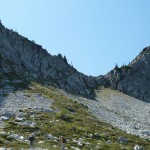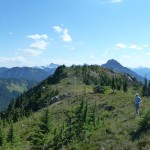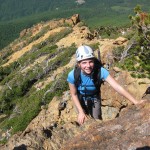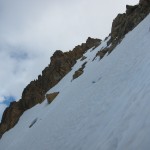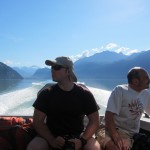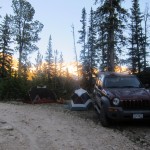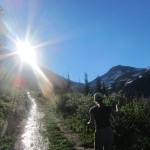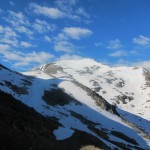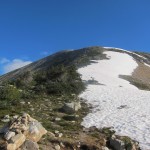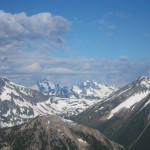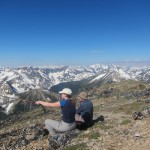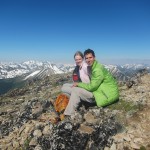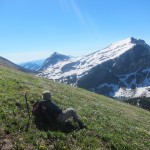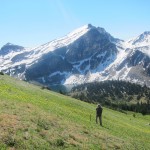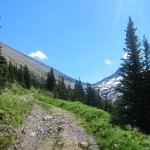Trip Date: Aug 11-13, 2013
Participants: Brittany Zenger, Geoff Zenger, Kris Wild (guide)
Difficulty: 5 (Mandatory climbing to 5.6, optional to 5.10a)
Gear: We climbed on two 30m ropes, and a small rack of small to mid-sized cams with a couple nuts.
Report: Ever since encountering a description and topo for the Matriarch, Macabre Tower, Grimface (MMG) traverse in Beckey’s Cascade Alpine Guide a couple years ago, it’s been near the top of my list of routes that I’d like to do. Described as a classic traverse of three peaks over an exposed ridge on solid granite, requiring numerous climbing techniques, but never becoming excessively difficult, it appeared to be a great way to get a taste of alpine rock. In order to have a good chance of success, for our anniversary this year I decided to arrange for a guide to come with us into the southern parts of Cathedral Provincial Park to attempt the route. The route did not disappoint.
Brittany and I drove out to Keremeos Saturday evening (Aug 10) and camped in one of the pleasant forest service campgrounds along the Ashnola Creek FSR while an intense thunderstorm raged overhead. We woke up early Sunday morning to wet ground but clear skies, and travelled back to Keremeos where we met our guide Kris at the Ranch restaurant for breakfast just before 7 am. After a quick bite and filling out the requisite paperwork we headed back up the Ashnola road for approximately 48 km (to just past the 38 km marker) to the Centennial trail trailhead from which we departed a bit past 9 am. The road would be drivable by a low-clearance 2wd vehicle, but as the road is rough in places, the drive would go a fair bit quicker in a high clearance vehicle.
The first ~5km of the route into Wall Creek are on the Centennial trail, which was in great condition as it had recently been prepared for the upcoming Fat Dog trail race. After approximately 5km the trail branches, with the left branch clearly labelled as heading to Cathedral Lodge / Quinscoe Lake. To head up Wall Creek, take the right fork. The trail has a lot of deadfall in places, which led us at one point to end up off the trail for about 30 minutes, but for the most part it is easy enough to follow and as long as you stay on the north side of Wall Creek you will eventually return to the trail and to the beautiful camping meadows. We reached our camp site after just over 4 hours of hiking and sat down to prepare some soup and enjoy the sun, but the sun wasn’t to last and within the hour a thunderstorm came in to get us wet again. Luckily we found a tarp stashed nearby that we set up to keep ourselves dry as we ate our dinner, and after the storm died down, Kris and I headed up the slopes towards Grimface to explore the ledges below its south face, and made it back before the storm came back in again. We went to bed wondering whether the weather would be good enough in the morning for us to attempt the traverse.
We woke up early on Monday morning to clear blue skies, and set out quickly, beginning our march towards the Wall Creek-Ewart Creek col at about 6:45am. It took us about 40 minutes up to the col, from where we began our fun scramble up to the notch between Matriarch Mountain and Denture Ridge (including encountering a relaxing mountain goat on the route). It took us approximately 30 minutes up to the notch, and from there we roped up, put on our rock shoes (wear comfy ones!), and started on the technical part of the route around 8:30.
The climb to Matriarch mountain begins with a short pitch of low-5th up a gully, and then hits you quickly thereafter with a wild short exposed pitch of 5.6. Once on the ridge proper, it rambles along towards Matriarch through a series of short low-5th notches, eventually reaching a short wall just below the summit that has a 5.3 chimney on the left and 5.8 crack straight up the middle. We took the 5.8 crack up the middle, and reached the summit at about 9:45. From here, there is an exposed rappel into the first major notch, where there is a short bolted au cheval over the chockstone at the bottom. From here we went up and over another bump, followed by a longer rappel to a nice sandy ledge, and then a longer pitch up to a large flat and sandy ledge right below the blank wall / bolt ladder pitch. We reached the ledge just past 11 o’clock and ate and relaxed for 30 minutes as Kris worked to reassemble a wood & webbing ladder that he had constructed years earlier to make it easier to second the bolt ladder.
We got climbing again a bit past 11:30 with Kris leading the bolt ladder and setting up the newly repaired ladder for us to follow (the ladder is now properly stashed away at the top of the pitch. Please do not leave the ladder hanging off of the top bolt and in the wind after you use it!). Another short pitch brought us to the top of Macabre tower, and we shortly found ourselves rappelling / being lowered into the third major notch, this time having to climb over an exposed chockstone before reaching safety at a bolt on the far side. One move of 5.6 brings you up to a long scrambling section that eventually leads to a long rappel down a chimney, leading a ledge from which we downclimbed to the top of a large sand and scree gully that led back down to Wall Creek. Yet another few pitches of low-5th, scrambling, and lowering brought us up and over the final rib to the base of Grimface mountain, which we reached at about 1:40pm.
From here we climbed the route listed in Beckey’s book as the “Southeast Notch” route. Although it appears steep and exposed from below, the route in fact works its way up a series of quite unexposed mid-5th chimneys towards the summit of Grimface. For the final pitch, I elected to take a 5.9/5.10a slab variation straight up as I was on top-rope (the standard route cuts left, then right on ledges to keep the climbing to mid-5th), and we were on the summit at 2:40pm. Somehow, despite hearing thunder at times during the traverse, none of the storm clouds ever passed over us, and we had great (albeit very windy) weather for the entire route. We relaxed on the summit and took in the views back at our route and also down at the part of Cathedral Park to the north that’s far more visited than where we were staying.
From the summit, we headed down the NW ridge of Grimface (the route described in Gunn’s “Scrambles” book) to the first notch, where we removed our rock shoes, put our mountaineering boots back on, and headed down the easy sand slopes straight back to camp, reaching camp just before 5 o’clock, surprisingly exhausted. We relaxed for the evening and went to bed early.
We woke up around 7:30 on Tuesday, packed up camp, said goodbye to the salt-loving deer that had hung out at our camp since we arrived, and started on our 14km hike back to the cars. We managed to stay on the trail for the whole route out (it would be great if whoever goes in there next brings flagging ribbon to mark the trail better for future parties heading in), but didn’t move terribly quick, and it took us just as long to hike out as it took us to hike in. Nonetheless, by a quarter to 1 we were down at the cars and washing our limbs in Ashnola creek.
In conclusion, it was a fantastic trip. The route itself was phenomenal with good rock, exciting exposure, and plenty of interesting but not difficult climbing, the camping location is beautiful, and our guide (Kris) was great as well. I would highly recommend him to anyone looking for a great day to have fun and push their limits in the mountains. In all, this was a great introduction to alpine rock climbing.



